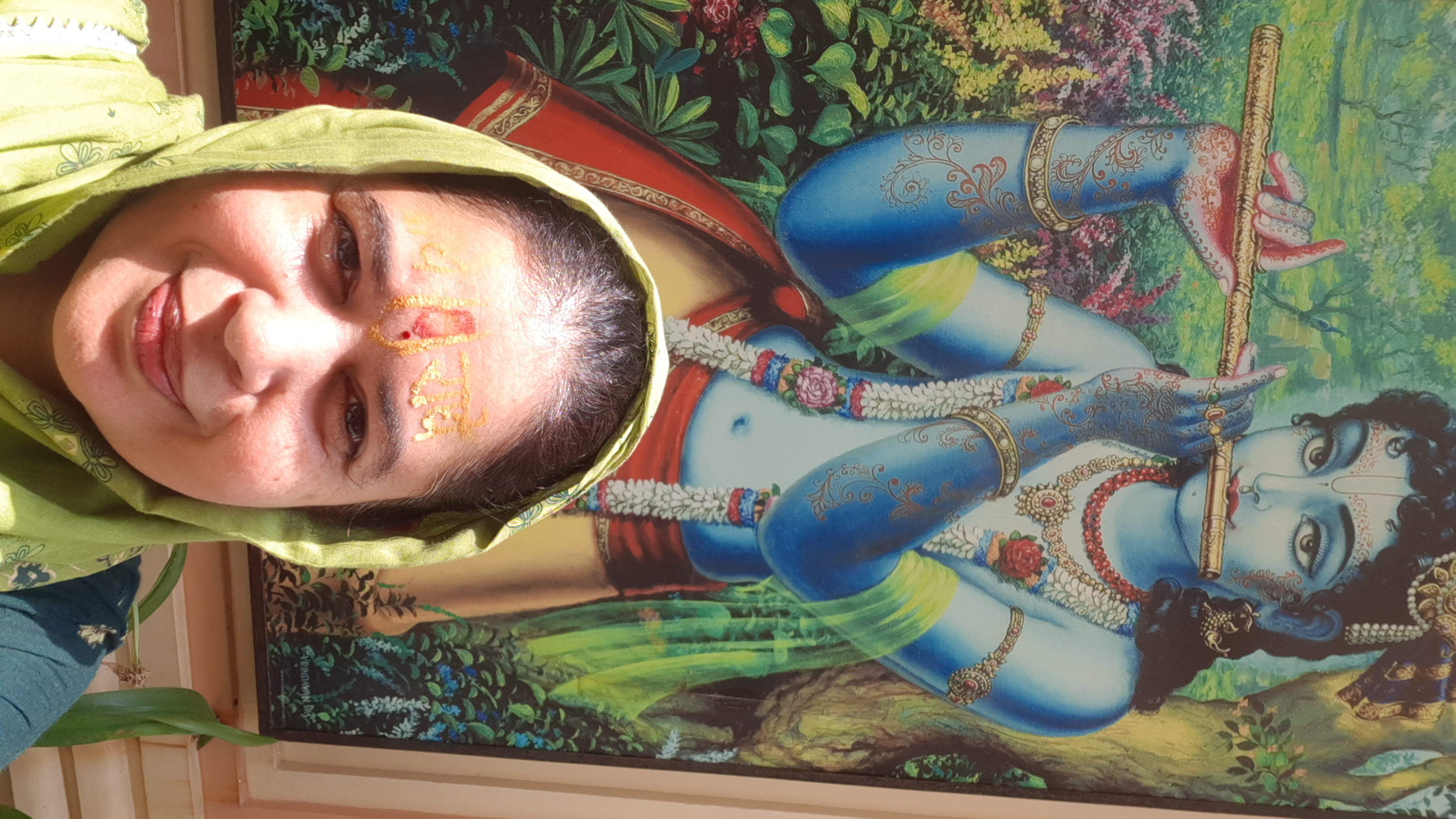If you are reading this blog, then you already know what the Srimad Bhagavatham is. Maybe you have read it already, or planning to read based on what you have heard about it. If Srimad Bhagavatham (SB) is on your bucket list of books to read, then this blog is for you.
Five years ago, all I knew about SB was that it contained a treasure trove of stories about Krishna. I purchased ISKCON’s SB, with A.C Bhaktivedanta Swami Prabhupada’s commentaries – 18 volumes in all. It stayed on my book shelf in my bedroom, and gathered dust as days went by. On January 15, 2016, I removed the clingwrap on the first Canto, sat down with a book and pen, and my life has not been the same since.
12 months later, I finished the last shloka in Canto 10 (saved the best for the last, as Canto 10 relates exclusively the stories of Lord Krishna!) It is simply impossible for me to explain in words the subtle transformation that happened as I read SB. But before I try and explain why you should read it, here is a quick summary based on my research notes.
12 Cantos. 335 chapters. 14,326 shlokas. The actual number of shlokas in each publication could be different as commentators may club shlokas/chapters together for coherence and/or translation purposes. My statistics is based on Prabhupada’s (ISKCON’s) 18-volume Srimad Bhagavatham. In fact, in the Srimad Bhagavatham itself, it is mentioned that the Bhagavata Purana is supposed to have 18,000 shlokas. (SB: Canto 12, Chapter 7)
The Srimad Bhagavatham is a maha purana, along with 17 other famous puranas like Padma, Skanda, Brahma, Narada, Matsya, Garuda, Kurma and so on. There are specific criteria for a body of work to be called a purana. At the very least, it has to explain: creation of the universe and the world around us, maintenance and sustenance, expand on dynasties of kings and rulers, annihilation or destruction of the universe, and of divine personas that offer protection and benedictions.
The list of the key stories in the 12 cantos are below:
- Canto 1: Greatness of SB, Vyasa’s confusion and Narada’s instruction, Vyasa starts composing the SB, Saving of Maharaj Parikshit in Uttara’s womb, Passing away of Bhishma, Disappearance of Lord Krishna, Parikshit gets cursed, Appearance of Suka Goswami
- Canto 2:Process of creation, Background for Maha Vishnu’s avatars, Questions by Maharaj Parikshit, and Suka’s narration starting with how SB is the answer to all problems.
- Canto 3: Vidura’s enquiry of Sage Maitreya, Creation of the Universal form and Brahma, Brahma’s search for the source of creation, Divisions of creation, Calculation of Time, the Sanat Kumaras, Varaha Avatar, Devahuti’s story, Lord Kapila avatar, His instructions to His mother
- Canto 4: Daughters of Swayambhu Manu, Daksha and Sati, Dhruva charitam, Prithu Maharaj, Rudra geetam, story of Prachetas
- Canto 5: Rishabha deva/Bharata/Jada Bharata incarnation, Descent of Ganga, Movement of the celestial planets, description of Ananta
- Canto 6: Ajamila, Narayana Kavacham, Chitraketu, Diti, Pumsavana vow by wives for their husbands
- Canto 7: Prahlada and Narasimha avatar
- Canto 8: Gajendra Moksham, Kurma avatar, Nectar from the churning of the ocean, Vamana avatar, Matsya avatar
- Canto 9: Sukanya, Ambarisha maharaj, Sree Rama avatar, His descendants starting from Kusa; Pururuvas and Urvashi, Parasurama avatar, Yayati, Prelude to Lord Krishna avatar
- Canto 10: Lord Krishna’s avatara
- Canto 11:Curse upon Yadu dynasty, Explanations of avatars, Instructions to Uddhava (Udhava Geetha), Instructions on detachment, renunciation and knowledge
- Canto 12: Kali yuga, Symptoms of Kali, Bhumi gita, Final instructions to Parikshit maharaj and his passing away, Markendeya, Summary and glories of SB
Now for the three very important, very tangible reasons why you should read this book.
- A literary masterpiece: A piece of literature is classic for some very precise reasons – great plots, incisive character sketches, elaborate settings, intense dialogues, and unfolding of the story that captures the attention of even the most wandering of minds. Srimad Bhagavatham is a literary masterpiece of the highest order; a classic that gets better with every shloka. Srimad Bhagavatham unfolds as a “mother of all question-answer sessions” happens between Maharaj Parikshit and Sage Suka. The maharaj has just seven days to live before a serpent kills him. He approaches Sage Suka and asks him all his doubts regarding life and death, and the story behind how Lord Krishna saves him in his mother’s womb. The king’s questions, Sage Suka’s answers that also refers to numerous other conversations and question-answer sessions between other kings and sages, references and repetition to key lessons and learnings, elaborate sthuthis (poems of praises) that highlight the beauty of the Sanskrit language,……..before you know it, 335 chapters are over. Granted that the SB does not follow a linear method of story telling. But that is also why you cannot afford to let your mind wander! The constant questions and the precise but elaborate answers ensures that you are always in the moment – body and soul.
- A perfect combination of philosophy and stories: When you read the Bhagavad Gita, you know what to expect – one of the best treatises on the art of living, dying and everything in between. Now imagine the depth of the Gita along with a whole gamut of exciting and entertaining stories about famous and not so famous characters that you have read about? It turns into a racy read, where when one story has reached its climax, another one is already brewing around the corner. All it takes is a single question from the king and you are thr0wn headlong into another series of tales with new characters, settings and lessons. If I could draw a simile? Imagine combining the intense philosophy of a thousand Bhagavad Gitas with the action packed and exciting Arabian Nights? This simile just about conveys some of the amazing experiences you will come across when you read Srimad Bhagavatham.
- Art of Life: While you may seriously not want to read at end about the incessant war between the devas and the asuras, or about dynasties and lineages, what you would love to read is how the essence of the art of life is propagated throughout the work. Detachment amidst misery and happiness, understanding amidst profit and loss, fulfillment amidst life and death, surrendering amidst pride and humility…..we could fill a 300-page note book and not even scratch the surface of the lessons of life that Srimad Bhagavatam shows, explains, teaches, demonstrates and reveals. Daily religious rituals, detailed explanation of creation and destruction, the psyche of the divine soul within and around us, dissection of the mind, ego, intellect and senses – the sheer scale of what Srimad Bhagavatham successfully undertakes to reveal is mind-numbing.
Reading the Srimad Bhagavatham is not an ordinary undertaking. But it is not impossible either. Once you read the first chapter, you are hooked, and will get drawn into it steadily, sometimes against your will. Whether you embark on it as a literary masterpiece or to find out answers to your spiritual questions or simply because you want to surrender at Lord Krishna’s Lotus Feet, reading the Bhagavatham puts you immediately on the fast-track for self-enquiry. Once you are on this path, there is no turning back. Nor would you want to.
Dedication:
This blog is dedicated to my guru, Radhika chechi, whose Narayaneeyam classes for over 18 months kindled in me the desire to read the source for Melpathur Bhattathiri’s inspiration. Her humility, love for Lord Krishna, and her constant encouragement showed me the way. Her advice was simple and practical – “just one chapter a day, moley”. My heartfelt gratitude and humble pranaams.
Sources:
- AC Bhaktivedanta Swami Prabhupada’s commentaries on Srimad Bhagavatham
- Kamala Subramaniam’s Srimad Bhagavatham
- Weekly Narayaneeyam and Srimad Bhagavatham classes by my guru, Radhika chechi



